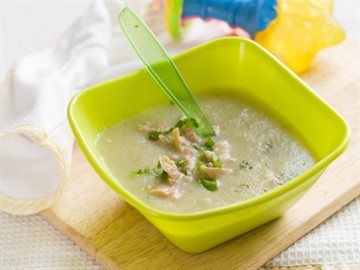8 months is one of the most interesting periods in a baby’s development—the first teeth have already erupted, the little one is actively moving, playing and testing everything he sees. Nutrition during this period should correspond to the stages of development; more and more new ingredients are introduced into the diet. In addition to mother’s milk, the baby tries “adult” food, and the mother carefully monitors the baby’s reaction. But you shouldn’t let your baby try everything; there are a number of foods that can only be given to older children. And a child’s diet at 8 months, especially if breastfed, should be varied, healthy and tasty.
In addition to breast milk, the nutrition of an eight-month-old child should be varied, healthy and tasty.
Rules for attaching a baby to the breast
The duration of breastfeeding largely depends on the technique of attaching the baby to the breast. Therefore, it is important to follow the following rules:
- take the baby in your arms and take a comfortable position;
- squeeze a drop of milk from the nipple and move the nipple along the baby’s lower lip;
- wait until the baby opens his mouth wide;
- place the nipple in his mouth so that the baby’s lower lip is low under the nipple;
- check that the baby is latching onto the breast correctly; his lips are turned out and capture the areola;
- It shouldn't hurt you when your baby nurses.
Up
Help with hypogalactia (lack of milk)
- Positive attitude and self-confidence. Family support and communication with mothers who have had positive breastfeeding experiences.
- Knowledge about lactation crises (temporary decrease in milk production): at 3-6 weeks, 3.4, 7, 8 months of lactation. Their duration is no more than 3-7 days. They do not pose a danger to the child's health. During these periods, it is necessary to increase the frequency of putting the baby to the breast. You should not offer your baby formula from a bottle (as a last resort, you can offer it from a spoon).
- Organize a “free” feeding schedule. Don't skip night feedings. Increase the frequency of breastfeeding. Offer both breasts at one feeding.
- While the baby is suckling on one breast, massage the other breast and stimulate the nipple with your fingers.
- If the baby sleeps for a long time and there is milk in the breast, express it with a breast pump.
- Take up to 1.5-2 liters of liquid per day (drink a glass of warm drink 10-15 minutes before feeding and after feeding).
- Take specialized food products for nursing mothers, lactogenic teas, vitamin and mineral complexes for nursing women.
- Before each feeding, irrigate the mammary glands with a warm shower, followed by a massage with a soft terry towel in a clockwise direction and longitudinal movements from the base of the breast to the nipple.
- Eat nutritiously, try to get enough sleep and avoid excessive physical activity.
Up
Average daily food intake for lactating women
The average daily set of food products for lactating women, fully meeting their physiological needs for nutrients and energy
- wheat bread 150g;
- rye bread 100g;
- wheat flour 20g;
- cereals, pasta 70g;
- potatoes 200g;
- vegetables 500g;
- fruit 300g;
- juices 150g;
- dried fruits 20g;
- sugar 60g;
- confectionery products 20g: dry cookies, crackers, unsalted crackers, marshmallows, marshmallows, marmalade, halva, sweets (caramel, bars, milk toffee) 2-3 pcs. per day, breakfast cereals (corn flakes);
- meat, poultry (low-fat varieties) 170g; Ready-made meat products such as sausages, frankfurters, sausages are undesirable;
- fish 70g; fatty fish, such as trout, mackerel, lake salmon, sardines, lightly salted herring - up to 50-70g per day 3-4 times a week;
- milk, kefir and other fermented milk products 2.5% fat 600g;
- cottage cheese 9% fat 50g;
- sour cream 10% fat 15g;
- butter 25g;
- vegetable oil 15g;
- egg ½ pcs.;
- cheese 15g;
- tea 1g;
- coffee 3g;
- salt 8g.
Up
Diet of a child aged 4 - 6 months
Your baby is already 4 months old. He has grown noticeably, become more active, is interested in objects that fall into his field of vision, looks attentively and reaches out to them. The child’s emotional reactions have become much richer: he smiles joyfully at all the people he sees more and more often, and makes various sounds.
Are you still breastfeeding your baby or have you had to switch to mixed or bottle feeding? The child is actively growing, and only with breast milk or infant formula can he no longer receive all the necessary nutrients. This means that it is time to think about complementary feeding.
The optimal time to start introducing it is an interval of 4 to 6 months, regardless of whether the baby receives breast milk or formula. It is at this time that children respond best to new foods. Until 4 months, the baby is not yet ready to accept and digest any other food. And with the late introduction of complementary foods - after 6 months, children already have significant deficiencies of certain nutrients and, first of all, micronutrients (minerals, vitamins, long-chain polyunsaturated fatty acids, etc.). In addition, children at this age often refuse new foods, their development of chewing skills for thick foods is delayed, and inappropriate eating habits are formed. It is important to know that, strange as it may seem at first glance, with delayed administration of complementary feeding products, allergic reactions to them are more likely to occur.
In what cases is it advisable to give complementary foods as early as 4 months, and when can you wait until 5.5 or even 6 months? To resolve this issue, be sure to consult a pediatrician.
As a rule, at an earlier age (4 - 4.5 months), complementary foods are introduced to children at risk of developing iron deficiency anemia, as well as children with insufficient weight gain and functional digestive disorders.
The optimal time to start introducing complementary foods to a healthy baby is between 5 and 5.5 months of age.
The World Health Organization recommends that breastfed children be introduced to complementary foods from 6 months of age. From the point of view of domestic pediatricians, which is based on extensive practical experience and scientific research, this is only possible in cases where the child was born on time, without malnutrition (since in these cases the reserves of mineral substances are very small), he is healthy, grows well and develops. In addition, the mother must also be healthy, eat well and use either specialized fortified products for pregnant and lactating women, or courses of vitamin and mineral complexes. Such restrictions are associated with depletion of iron reserves even in an absolutely healthy child by 5–5.5 months of age and a significant increase in the risk of developing anemia in the absence of complementary feeding products rich or fortified with iron. Other deficiency states also arise.
The first complementary feeding product can be vegetable puree or porridge; it is better to give fruit puree to the baby later - after delicious sweet fruits, children usually eat vegetable puree and porridge worse, and often refuse them altogether.
Where is the best place to start? In cases where a child has a tendency to constipation or gains weight too quickly, preference should be given to vegetables. If there is a high probability of developing anemia, unstable stools and small weight gains, use baby cereals enriched with micronutrients. And if you started introducing complementary foods with cereals, then the second product will be vegetables and vice versa.
If the first complementary foods are introduced at 6 months, it must be baby porridge, enriched with iron and other minerals and vitamins, the supply of which through breast milk is no longer sufficient.
Another important complementary feeding product is meat puree. It contains iron, which is easily absorbed. And adding meat to vegetables improves the absorption of iron from them. It is advisable to introduce meat puree to a child at the age of 6 months. Only daily use of children's fortified porridge and meat puree can satisfy babies' needs for iron, zinc and other micronutrients.
But it is better to introduce juices later, when the child is already receiving the main complementary foods - vegetables, cereals, meat and fruits. After all, complementary feeding is needed so that the baby receives all the substances necessary for growth and development, and juices contain very little of them, including vitamins and minerals.
Juices should not be given in between feedings, but after the child has eaten porridge or vegetables with pureed meat, and also as an afternoon snack. The habit of drinking juices between meals leads to frequent snacking in the future, a love of sweets is instilled, children are more likely to develop tooth decay and the risk of developing obesity increases.
With the beginning of the introduction of complementary foods, the child is gradually transferred to a 5-time feeding regimen.
Rules for introducing complementary foods:
- preference should be given to industrially produced children's products; they are made from environmentally friendly raw materials, have a guaranteed composition and degree of grinding
- a complementary feeding product should be offered to the child from a spoon at the beginning of feeding, before breastfeeding (formula feeding)
- the volume of the product increases gradually, we start with ½ - 1 spoon, and in 7 - 10 days we bring it to the age norm, subsequent products within the same group (porridge from other cereals or new vegetables) can be introduced faster, in 5 - 7 days
- We begin the introduction with monocomponent products
- -it is advisable to give a new product in the afternoon; it is important to monitor how the child reacts to it
- new products are not introduced in the event of acute diseases, as well as before and immediately after preventive vaccination (you should refrain for several days)
When introducing a new type of complementary food, try one product first, gradually increasing its quantity, and then gradually “dilute” this product with a new one. For example, you can start vegetable complementary feeding with a teaspoon of zucchini puree. For a week, give your baby only this product, gradually increasing its volume. After a week, add a teaspoon of broccoli or cauliflower puree to the zucchini puree and continue to increase the total volume every day. A vegetable puree made from three types of vegetables would be optimal. The portion must correspond to the age norm. Over time, you can replace the introduced vegetables with others faster.
After introducing one vegetable (bringing its volume to the required amount), you can move on to eating porridge, and diversify your vegetable diet later.
If the child does not like the dish, for example, broccoli, do not give up on your plan and continue to offer this vegetable in small quantities - 1-2 spoons daily, maybe not just once, but 2-3 times before meals, and after 7 - 10, and sometimes it takes 15 days for the baby to get used to the new taste. This will diversify the diet and help the baby form the right taste habits.
Spoon feeding should be done patiently and carefully. Force feeding is unacceptable!
In the diet of healthy children, porridge is usually introduced after vegetables (with the exception of healthy breastfed children, when complementary feeding is introduced from 6 months). It is better to start with dairy-free, gluten-free porridges - buckwheat, corn, rice. It is important to use commercially produced baby food porridge, which contains a complex of vitamins and minerals. In addition, it is already ready for use; you just need to dilute it with breast milk or the formula that the baby receives. For children suffering from food allergies, complementary foods are introduced at 5 – 5.5 months. The rules for introducing products are the same as for healthy children; in all cases, it is introduced slowly and starts with hypoallergenic products. Individual tolerance must be taken into account. The only difference is in adjusting the diet taking into account the identified allergens. For meat products, first preference should be given to turkey and rabbit puree.
Diets for different age periods
It is better to explain how you can create a diet using several examples that will help you navigate in creating a menu specifically for your child.
From 5 months, the volume of one feeding averages 200 ml.
Option 1.
If your child began receiving complementary foods from 4 to 5 months, then at 6 months his diet should look like this:
| I feeding 6 hours | Breast milk or VHI* | 200 ml |
| II feeding 10 hours | Dairy-free porridge** Supplementation with breast milk or VHI* | 150 g 50 ml |
| III feeding 14 hours | Vegetable puree Meat puree Vegetable oil Supplementation with breast milk or VHI* | 150 g 5 – 30 g 1 tsp. 30 ml |
| IV feeding 18 hours | Fruit puree Breast milk or VHI* | 60 g 140 ml |
| V feeding 22 hours | Breast milk or VHI* | 200 ml |
* - infant formula ** - diluted with breast milk or VHI
Option 2.
Another option for the diet of a 6-month-old child, if complementary feeding was introduced from 4 to 5 months:
| I feeding 6 hours | Breast milk or VHI* | 200 ml |
| II feeding 10 hours | Dairy-free porridge** Fruit puree | 150 g 20 g |
| III feeding 14 hours | Vegetable puree Meat puree Vegetable oil Fruit juice | 150 g 5 – 30 g 1 tsp. 60 ml |
| IV feeding 18 hours | Fruit puree Breast milk or VHI* | 40 g 140 ml |
| V feeding 22 hours | Breast milk or VHI* | 200 ml |
* - infant formula ** - diluted with breast milk or VHI
Option 3.
Approximate daily diet for a 6.5-month-old breastfed child, if complementary foods were introduced at 6 months:
| I feeding 6 hours | Breast milk | about 200 ml |
| II feeding 10 hours | Dairy-free porridge** Supplementation with breast milk | 100 g |
| III feeding 14 hours | Vegetable puree Meat puree Vegetable oil Supplementation with breast milk | 100 g 5 – 30 g 1 tsp. |
| IV feeding 18 hours | Breast milk | about 200 ml |
| V feeding 22 hours | Breast milk | about 200 ml |
** - diluted with breast milk
Up to 7 months, you should increase the volume of porridge and vegetable puree to 150 g and introduce fruit puree.
The materials were prepared by employees of the department of nutrition of healthy and sick children of the Scientific Center for Children's Health and are based on the recommendations given in the “National Program for Optimizing Feeding of Children of the First Year of Life in the Russian Federation”, approved at the XV Congress of Pediatricians of Russia (02.2009)
Up
Principles of feeding an eight-month-old baby
The eight-month-old baby is growing and developing rapidly. During this period, most infants sit, begin to crawl, and actively move. A child needs a complete and varied diet, which will provide the small body with the necessary nutrients, microelements, and vitamins. New products are introduced, and a child’s menu at 8 months becomes more varied and nutritious.
At this age, it is important to accustom your baby to a certain schedule and try to stick to it. The optimal regimen for an eight-month-old baby is five meals a day, every four hours. The total volume of food reaches one liter (about 200 g at one time).
For a convenient feeding process, it is better to sit the baby in a special chair in which he is well secured. In addition, the baby is much calmer and more comfortable in his own territory. Bright children's dishes and a playful way of serving food turn feeding into a fun and interesting activity.
Advice. In order to involve the child in the process, it is recommended to give him the opportunity to eat on his own. There is no need to worry that it will get dirty or scatter food. The pleasure with which your child will learn a new activity is worth it. Thus, you can feed your baby well, and he will master the skills of using equipment.

The child tries to eat on his own
Diet of a child aged 7 months
When creating a diet for a seven-month-old baby, distribute the foods so that you get a prototype of a menu for an already grown-up child with breakfast and lunch.
At this age, the yolk of a boiled chicken egg is introduced into the child’s diet - a valuable source of fat, vitamin B12, A, phosphorus and selenium. Chopped yolk can be added to porridge or vegetable puree.
At 7 months, you can already give your child crackers (in the form of dried bread) and baby cookies.
The volume of fruit puree and juice increases to 70 g.
It is still better to give preference to commercially produced complementary foods, given their high degree of safety and varied range. If the baby does not accept the new product the first time, it can be mixed with an already familiar product.
Approximate diet of a child aged 7 months.
| I feeding 6 hours | Breast milk or VHI* | 200 ml |
| II feeding 10 hours | Dairy-free or milk porridge ** Butter Yolk of a boiled chicken egg Supplementation with breast milk or voluntary medical insurance | 150 g about ½ tsp. ¼ piece 50 ml |
| III feeding 14 hours | Vegetable puree Vegetable oil Meat puree Fruit juice | 170 g about 1 tsp. 30 g 70 ml |
| IV feeding 18 hours | Fruit puree Baby cookies Supplementation with breast milk or VHI | 70 g 1-2 pcs 130 ml |
| V feeding 22 hours | Breast milk or VHI | 200 ml |
* - infant formula ** - dairy-free porridge should be diluted with breast milk or infant formula that the child receives. Milk porridge is diluted with water.
Approximate diet for a 7 month old child with an allergy to cow's milk proteins:
| I feeding 6 hours | Breast milk or formula for infants intolerant to cow's milk proteins | 200 ml |
| II feeding 10 hours | Dairy-free porridge* Vegetable oil Fruit puree (apple, pear) | 130 g 1/2 tsp. 70 g |
| III feeding 14 hours | Vegetable puree Vegetable oil Meat puree (rabbit, turkey) | 170 g 1 tsp. 30 g |
| IV feeding 18 hours | Vegetables or dairy-free porridge** Vegetable oil Meat puree | 180 g 1/2 tsp. 20 g |
| V feeding 22 hours | Breast milk or formula for infants intolerant to cow's milk proteins | 200 ml |
* - dairy-free porridge should be diluted with breast milk or a medicinal formula for children with intolerance to cow's milk proteins. ** - you can either alternate porridge or vegetables, or offer a mixed dish - porridge with vegetables.
Up
How to properly introduce new foods into your baby’s diet?
You should start complementary feeding with new foods with small doses - 1-2 tsp. The best time is the second feeding. It is necessary to monitor the baby’s reaction for 3 days: whether there are any allergies, whether the stool has changed. If everything is in order, the single serving can be increased to 5 tsp. (25 grams). You should not overload your baby's body with complementary foods.

You need to learn to understand the baby’s signals; if the baby is full, he:
- turns his head, indicating that he doesn’t want to eat anymore;
- closes his mouth and turns away;
- distracted, misbehaves, throws food.
When the baby is hungry, he:
- enjoys food;
- looks at food while feeding;
- willingly opens his mouth and reaches for the spoon.
It is useful to keep a feeding diary to find out food intolerances and taste preferences of the baby.
Diet of a child aged 8 months
You can start introducing fish into your children’s diet in the ninth month. Along with animal meat, fish is a source of complete protein with a well-balanced composition of amino acids, fat, vitamins B2, B12 and minerals. Compared to meat, fish contains 5 times less connective tissue, due to which it boils quickly, has a delicate consistency after heat treatment and is easier to digest. Fish oil is characterized by a high content of polyunsaturated fatty acids, including the ω-3 class. These substances are necessary for the child to mature the brain, retina, strengthen the cardiovascular and immune systems. Sea fish contains microelements that are important for the child’s body, such as iodine and fluorine. The child should be given 1-2 times a week instead of meat, being sure to monitor how the child tolerates fish in general and its individual varieties. Preference should be given to ocean fish, preferably white (cod, hake, pollock), red salmon can be recommended, and river fish - pike perch, carp.
Self-cooked fish is given to the child with boiled and pureed vegetables. You can also offer your baby canned fish and vegetables, but they contain only 10 - 20% fish.
At this age, when all the main food groups have already been introduced, special attention should be paid to the diversity of the composition of dishes. New, possibly combined products are being introduced, for example, not only purees from various fruits and berries, but also their combinations with cottage cheese, cream, cereals, etc.
From 8 months, the child’s diet can be expanded to include fermented milk products (baby kefir, biokefir, bifidokefir, yogurt, bioyogurt, biolact). Fermented milk products are prepared using a special starter that breaks down milk protein, so that the baby can receive an essential set of amino acids in a readily accessible form. Fermented milk products improve the composition of the child’s intestinal microflora and are rich in B vitamins and calcium. Their regular consumption has a beneficial effect on the functioning of the intestines, stimulates appetite, and increases the absorption of micronutrients. Children's fermented milk products are introduced into the baby's diet gradually, starting with 1 tsp. and if well tolerated, increase their volume to 150-200 ml per day.
Sample menu for a healthy 8 month old baby
| I feeding 6 hours | Breast milk or infant formula | 200 ml |
| II feeding 10 hours | Dairy-free* or milk porridge Butter Boiled egg yolk Fruit puree Fruit juice | 180 g ½ tsp. 1/2 pcs. 20 g 30 ml |
| III feeding 14 hours | Vegetable puree Vegetable oil Meat puree Fruit juice | 170 g 1/2 tsp. 50 g 50 ml |
| IV feeding 18 hours | Cottage cheese Children's cookies Fruit puree Breast milk (BHI) or children's kefir (yogurt) | 40 g 1 - 2 pcs. 40 g 100 ml |
| V feeding 22 hours | Breast milk or infant formula | 200 ml |
* - diluted with breast milk, infant formula or water
Approximate daily diet for an 8-month-old child with an allergy to cow's milk proteins
| I feeding 6 hours | Breast milk or medicated formula for children with allergies to cow's milk proteins | 200 ml |
| II feeding 10 hours | Dairy-free* porridge Vegetable oil Fruit puree (apple, pear) | 120 g 1 tsp. 80 g |
| III feeding 14 hours | Vegetable puree Vegetable oil Meat puree | 170 g 1 tsp. 40 g |
| IV feeding 18 hours | Vegetable puree or porridge Vegetable oil Meat puree | 170 g 1 tsp. 30 g |
| V feeding 22 hours | Breast milk or medicated formula for children with allergies to cow's milk proteins | 200 ml |
* - diluted with breast milk or medicinal formula for children with allergies to cow's milk proteins
Up
Features of complementary feeding for an eight-month-old baby
Frequent problems when introducing complementary foods at 8 months are refusal of new foods and allergic reactions to foods. That's why some mothers hesitate to feed their babies for a long time.
Meanwhile, pediatricians explain the rules of complementary feeding; if you follow them, then no difficulties will arise. The main thing is to eliminate the reasons for the child’s reluctance to eat new foods, for example, illness, teething, stress during the transition to an unusual diet.
Feeding a breastfed baby
Until a certain age, the child replenishes his supply of vitamins and minerals through breastfeeding; there is no need to introduce additional products. After six months, mother's milk no longer meets the needs of the growing body, so the need for complementary feeding arises.
For your information. Experts warn that complementary feeding at 8 months during breastfeeding should not be rushed or delayed, so as not to cause the baby to protest against changing the diet.
Basic principles of complementary feeding
Dr. Komarovsky and other pediatricians advise adhering to the principles of introducing complementary feeding to an 8-month-old breastfed baby:
- Each product is introduced 3 days after the previous one;
- Give a new dish in the first half of the day to monitor negative reactions until the evening;
- A portion of complementary foods is much smaller than a portion of breast milk, since breastfeeding remains the main type of nutrition.
Basic complementary feeding mistakes
It is known that proper nutrition of a baby has a positive effect on his growth and development. Modern research shows that errors in nutrition increase the risk of allergies and obesity:
- stopping breastfeeding too early, although breast milk protects against allergies;
- overfeeding a child, leading to the deposition of excess visceral fat (around internal organs) and metabolic disorders;
- introducing products earlier or later than recommended.

When introducing a new complementary feeding product, the basic principles of nutrition for an 8-month-old child must be followed.
Diet of a child aged 9-12 months
By 9 months The main complementary foods have already been introduced, so the expansion of the child’s diet continues. It is important to know that at this age the consistency of products should change from homogenized to finely and coarsely ground. A meat dish for an older child can be offered in the form of meatballs, which will diversify the child’s diet and stimulate the development of chewing skills. Industrially produced canned meat for children over 8 months. - coarsely ground, spices and herbs can be added to them (white pepper, celery, parsley, dill, onion, basil, thyme).
The volume of fish puree increases to 60 g per day by 12 months. Fish is given 2 times a week boiled without broth (instead of meat).
At this age, you can offer your child baby noodles.
The amount of children's cookies and crackers is increased to 10-15 g per day (2-3 cookies).
As the year approaches, it is useful to add finely chopped fresh garden herbs (dill, parsley) to various dishes, which significantly enriches the diet with vitamins and minerals.
Approximate diet for a 12 month old child
| breakfast 8 o'clock | Dairy-free or milk porridge* Butter Boiled egg yolk Fruit puree | 150-200 g 1 tsp. 1/2 pcs 50 g |
| lunch 12 o'clock | Milk porridge Butter Fruit puree | 120-130 g 6 g 90 g |
| afternoon tea 16 o'clock | Breast milk (kefir or yogurt)** Cottage cheese Fruit puree Baby cookies | 100 g 50 g 50-70 g 2 pcs |
| dinner 20 o'clock | Vegetables or porridge** Meat puree Vegetable oil Fruit juice | 180 g 20 g 1/2 tsp. 50 ml |
| 23 hours before bed | Breast milk (BMS)*** | 200 ml |
* - dairy-free porridge should be diluted with breast milk or infant formula that the child receives. Milk porridge is diluted with water. ** - daily volume of kefir or yogurt can be up to 200 ml, *** - infant formula
Approximate diet for a 12 month old child with an allergy to cow's milk proteins:
| breakfast 8 o'clock | Dairy-free porridge* Vegetable oil Fruit puree | 150-200 g 1 tsp. 50 g |
| lunch 12 o'clock | Vegetable puree Vegetable oil Meat puree/meatball Bread/cracker Compote | 180 g 1/2 tsp. 50-70 g 10 g 50 ml |
| afternoon tea 16 o'clock | Breast milk or formula for children with cow's milk protein intolerance Fruit puree Crackers | 150-180 ml 50 g 10 g |
| dinner 20 o'clock | Vegetables or dairy-free porridge** Vegetable oil Meat puree Fruit juice | 180 g 1/2 tsp. 30-40 g 50 ml |
| 23 hours before bed | Breast milk or formula for infants intolerant to cow's milk proteins | 200 ml |
* - dairy-free porridge should be diluted with breast milk or a medicinal formula for children with intolerance to cow's milk proteins. ** - you can either alternate porridge or vegetables, or offer a mixed dish - porridge with vegetables.
The materials were prepared by employees of the department of nutrition of healthy and sick children of the Scientific Center for Children's Health and are based on the recommendations given in the “National Program for Optimizing Feeding of Children of the First Year of Life in the Russian Federation”, approved at the XV Congress of Pediatricians of Russia (02.2009)
Up
Sample menu for the week
The baby should eat a varied and healthy diet. Taking into account the recommendations of pediatricians, and the fact that at 6-30 and 21-30 the baby always eats formula or mother’s milk, an approximate menu for a child at 8 months for a week could be like this.

Monday:
- 10-30. Porridge with milk (150 g), half an yolk, carrot-apple puree (50 ml), tea;
- 14-30. Broth (30 ml), vegetable puree with meat (170 g), juice (50 ml), homemade white bread croutons;
- 18-00. Cottage cheese diluted with kefir (150-200 g), cookies.
Tuesday:
- 10-30. Buckwheat porridge with water (40 g), yogurt (150 ml), applesauce (50 g);
- 14-30. Puree soup with meatballs (170 g), carrot juice (40 ml);
- 18-00. Milk porridge with pumpkin (170 g), blackcurrant juice (40 ml).
Wednesday:
- 10-30. Vegetable puree (40 g), bio-yogurt (150 ml), plum puree (50 g);
- 14-30. Zucchini and potato soup (150 ml), 0.5 tsp. butter, peach juice (20 ml);
- 18-00. Milk oatmeal (170 g), carrot juice (20 ml).
Thursday:
- 10-30. Cottage cheese (40 g), dried fruit compote (150 ml), tea;
- 14-30. Cauliflower puree (150 g), half an yolk, liver puree (30 g), peach juice (40 ml);
- 18-00. Corn porridge with milk and pumpkin (170 g), apple juice (40 ml).
Friday:
- 10-30. Millet porridge with water, tea (150 ml), apple and plum puree (60 ml);
- 14-30. Pumpkin and rice soup (170 g), turkey puree (30 g);
- 18-00. Buckwheat porridge with milk (170 g), carrot juice (20 ml).
Saturday:
- 10-30. Cauliflower puree (150 ml), banana puree (60 g), compote;
- 14-30. Potato and pumpkin soup (150 g), hake puree (30 g), plum juice (40 ml);
- 18-00. Barley milk porridge (150 g), cherry juice (20 ml).
Sunday:
- 10-30. Yogurt (40 g), milk (150 ml), applesauce (20 g);
- 14-30. Broccoli puree with zucchini (170 g), rabbit puree (30 g), peach juice (40 ml);
- 18-00. Buckwheat porridge with milk (170 g), apple juice (20 ml).
It can be seen that each feeding includes 200-250 ml. With five meals a day, the baby receives almost 1000 ml of food. If the baby behaves calmly between feedings, it means that the amount of food is chosen correctly and the baby is full.

Broccoli puree for babies
When the baby already wants to have a snack 1-1.5 hours after eating, it is worth adjusting the calorie content of the diet. The feeding pattern can be changed taking into account the baby's taste preferences. With the correct feeding regimen, by 9 months the baby will gain almost 500 g in weight. At his age, this is considered the norm.
Solid food should be added to the diet; it develops the baby's chewing reflex.
Increase in body weight and height in the 1st year of a child’s life
For 1 month: weight gain 600g, height gain 3 cm. For month 2: weight gain 800g, height gain 3 cm. For month 3: weight gain 800g, height gain 2.5 cm. For month 4: weight gain 750g, height gain height 2.5 cm. For the 5th month: weight gain 700g, height increase 2 cm. For the 6th month: weight gain 650g, height increase 2 cm. For the 7th month: weight gain 600g, height increase 2 cm. For the 8th month: increase weight 550g, height increase 2 cm. For the 9th month: weight gain 500g, height increase 1.5 cm. For the 10th month: weight gain 450g, height increase 1.5 cm. For the 11th month: weight gain 400g, height increase 1, 5 cm. Over the 12th month: weight gain 350g, height increase 1.5 cm.











